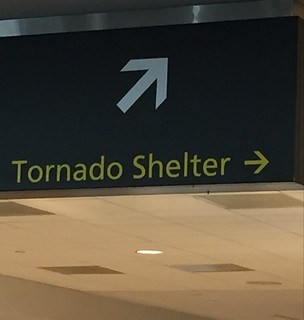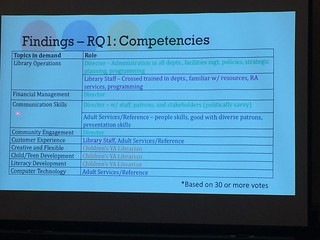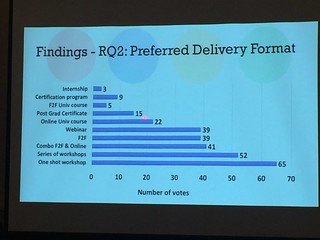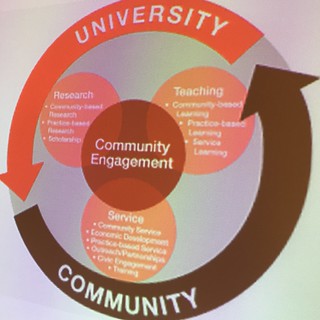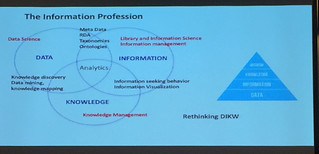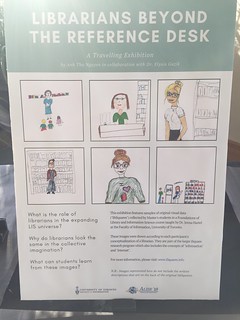Dietmar Wolfram began by talking about some of the current specializations that exist in MLIS programs and allied degree programs. ALISE wants to expand to include the emerging and expanding areas that our programs/schools are engaged in.
Anne Gilliland, UCLA
Archival education
Over 30 schools in North America
An expansion of scope -> archival studies
Archival studies was established at UCLA in 1995
There is one mandatory course, then students select courses that match the person’s trajectory. Some courses are offered in over academic programs.
Courses emphasize the proactive roles of archivists. UCLA’s Department of Information Studies emphasizes social justice.
How has the department benefited from archival studies?
- Increased enrollment.
- Emphasis on evidence supports the school’s social justice concerns.
- Multiple points of intersection with other areas of the department, as well as other academic departments.
- Built tighter connections with external communities.
Challenges include:
- Had to overcome stereotypes.
- Balancing faculty workload.
Best pedagogical practices include:
- Helping students to connect between their background and communities to their future careers. The classroom must be a safe space.
- Rethinking class lengths to allow for more depth during a class session. For example, having a class that meets in 8 hour blocks several times a semester.
Suliman Hawamdeh, Univ. Of North Texas
Trends:
- Branding and repositioning
- Relocation and merger with other programs
- Expansion of programs and specializations
- Pedagogical shift - move to more on campus courses for international students ( mostly from India)
- Multidisciplinary and interdisciplinary
- Move to focus on the broader information science
Opportunities and challenges include:
- Need for a different level of competencies
- Nice to learn vs need to learn
- Rich flexible curriculum
ALISE Academy Questions:
- What is the LIS profession? Who are our students?
- How can we brand our programs to demonstrate the versatility of our degrees?
- Given demographic trends, how can the many related associations be sustained?
- Should ALISE be the leader in developing alternatives to....?
UNT uses (informal) ”programs of study” to provide breadth to the MLIS program.
Their PhD. program uses 33 external faculty who are involved with supervision and mentoring. This is in addition to 16 faculty in I.S. One I.S. Faculty member must be on the student's committee.
Howard Rosenbaum, Indiana University
The School of Informatics, Computing, and Engineering
Department of Library and Information Science
One PhD, two master’s degrees, and some certificates.
M.S. of Information Science - 5 dual degree options
M.S.L.I.S. - 14 dual degree options
In a dual degree, the number of credits is reduced. This is helpful particular for students who want to go into academic libraries, where a second master’s will be particular helpful.
Most specializations have a faculty lead. That person advises all of the students in the specialization.
It every specialization or dual degree has students all the time, but all have had students in them.
Specializations have required electives and free electives.
The specializations help with course scheduling and the hiring of adjuncts. Once you know how many students are in a specialization,who can figure that out.
Challenges include:
- Assuring faculty to teach
- Low enrollment in classes
- Dual degrees must be approved by each department/school, then the campus, and the state. Specializations are approved by the Board of Trustees. He noted that most employers do not ask to see a student’s transcript.
Most students now take core classes in their first year, which helps with course planning.
Almost engaged in constant curriculum review.
Paul Sherman, Kent State
From a user experience program.
The global information challenge - bad actors
Dark pattern problem -> the fear of missing out -> isolation
How can we help? Sherman delivered a call to action, rather than talking about what his program does.
Discussion:
Should ALISE be the leader in developing alternatives to....?
Gilliland asked what is the profession that we are trying to serve? Are these professions ready for the changes our students might bring with them?
Rosenbaum - the problem of recruiting diverse populations has been a concern since his work in academia since the 1980s. He noted the lack of diversity in the room.
IS students are not interested in the L.
Sherman - we should be looking at educational programs, not just those that grant degrees. We need to be aware of our competition.
Question about competencies
Hawamdeh - can people do the job? That is more important that a grade. How do we integrate competency based education into what we do?
Rosenbaum - competencies depend on where the student is going to work. What is the profession that we’re trying to education students for?
Gilliland - she talked about this from an archives point of view. The archival field has two “mistresses.”
To what extent do undergraduate programs affect the culture of your school?
The MLIS degree requires a demonstration of LIS overarching concerns. How does this work with the structures that were discussed?
Rosenbaum - capstones for the specializations
Sherman - they offer a range of culminating experience. They suggest that students look for projects that will be relevant to hiring managers or projects at their current workplace.
Hawamdeh - have advanced seminars and independent studies. Students might produce a publication.
Gilliland - her university requires either a thesis or a portfolio option.
Comment about the lack of diversity. Research has shown that students before the age of 10-11 have decided/learned what they cannot be. We need to get outside of our “world.”
In what way do knew programs contribute to the information professions? How do they affect our mission?
Sherman - concentrate on mission. It is a losing proposition to focus on defining what you are.
Rosenbaum - They looked at their undergraduate students and creating undergraduate majors. About 10% of undergraduates do not know what they want to do. What could they go with that 10%? They looked at what they could do with that group? They allow students to take graduate classes in their senior year, so that students can quickly get an M.S. degree. Most though are currently interested in the I.S. Degree.
Wolfram - Introducing students with related undergraduate classes can provide a gateway to the LIS degree. It opens up career options for students.
What kind of value proposition to your pick to a partner in a dual degree program?
Hawamdeh - Students want to know what the degree will do for them.
Are programs aware of how many of their students are already practitioners?
Gilliland - Some applicants in archives enter the profession because they feel their community has not been well served by the archives profession.
Edited for types and reformatted: Feb. 11, 2018
 In January, Christopher Kenneally moderated a discussion between Richard Mandel, Jonathan Band, and James Grimmelmann on the future of digital first sale with the court case Capitol Records v. ReDigi providing context for the conversation. The result is a 38-minute podcast episode of Beyond the Book, which begins with an in-depth look at the ReDigi case and why it matters, then moves to thinking about "digital first sale" and "digital fair use" (especially in relation to libraries), and finally ends with Grimmelmann evoking analogies from Star Trek as a way of thinking about the future of this problem. This is worth listening to because it may likely present the problem in a way you had not yet considered. (And don't you want to know what Star Trek has to do with this??)
In January, Christopher Kenneally moderated a discussion between Richard Mandel, Jonathan Band, and James Grimmelmann on the future of digital first sale with the court case Capitol Records v. ReDigi providing context for the conversation. The result is a 38-minute podcast episode of Beyond the Book, which begins with an in-depth look at the ReDigi case and why it matters, then moves to thinking about "digital first sale" and "digital fair use" (especially in relation to libraries), and finally ends with Grimmelmann evoking analogies from Star Trek as a way of thinking about the future of this problem. This is worth listening to because it may likely present the problem in a way you had not yet considered. (And don't you want to know what Star Trek has to do with this??)


